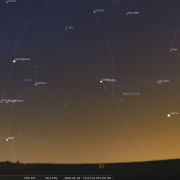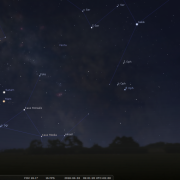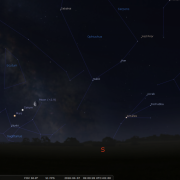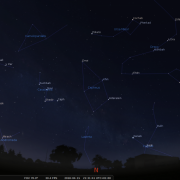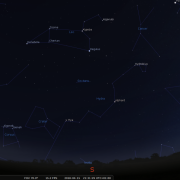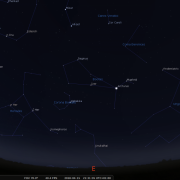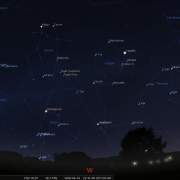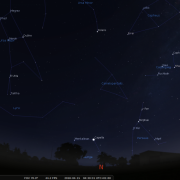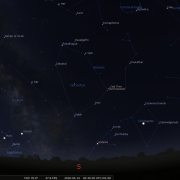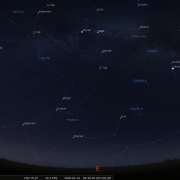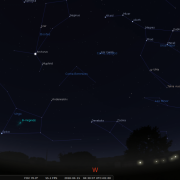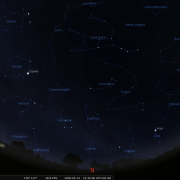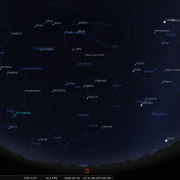In this month's Sky Notes:
Planetary Skylights
 The month starts with Venus low in the western evening twilight, a conspicuous ‘evening star’. As we head through April Venus slowly gains in altitude, becoming ever more conspicuous to the naked eye.
The month starts with Venus low in the western evening twilight, a conspicuous ‘evening star’. As we head through April Venus slowly gains in altitude, becoming ever more conspicuous to the naked eye.
Look for it and a very slim crescent moon in earthshine on the 17th and 18th. During the latter part of April Venus tracks up between the descending Pleiades and Hyades star clusters in Taurus. Viewed through a telescope Venus exhibits a definite gibbous phase, but little else is evident beneath the duvet of cloud cover.

 As Venus sets in the west around 22:00h, so Jupiter rises in the east, a conspicuous presence second only in brightness to Venus. Although a late evening object, Jupiter is for the time being still best observed in the dawn sky, when at its highest to the south. The Moon lies nearby on the 2nd and 30th.
As Venus sets in the west around 22:00h, so Jupiter rises in the east, a conspicuous presence second only in brightness to Venus. Although a late evening object, Jupiter is for the time being still best observed in the dawn sky, when at its highest to the south. The Moon lies nearby on the 2nd and 30th.

 Throughout March Mars has been edging toward Saturn low in the dawn sky, and April commences with the pair pretty close together. View on the 3rd when pearly Saturn resides just above the ochre lustre of Mars. Then on the 7th and 8th a waning crescent moon lies in close proximity to both planets. Telescopically Mars still appears very small, with little detail discernible; this will change in the coming months. Saturn, on the other hand is a glorious spectacle, with the rings wide open, easily resolved in the smallest of instruments – binoculars aside.
Throughout March Mars has been edging toward Saturn low in the dawn sky, and April commences with the pair pretty close together. View on the 3rd when pearly Saturn resides just above the ochre lustre of Mars. Then on the 7th and 8th a waning crescent moon lies in close proximity to both planets. Telescopically Mars still appears very small, with little detail discernible; this will change in the coming months. Saturn, on the other hand is a glorious spectacle, with the rings wide open, easily resolved in the smallest of instruments – binoculars aside.
Meteors

The Lyrid meteor shower (April 16-25th) peaks in the early morning hours of April 22nd , fortunately after a waxing moon has set. The chances of spotting some shooting stars will therefore be quite favourable. The shower occurs as the Earth passes through the dust left over from Comet Thatcher (C/186 G1), which makes a full orbit of the sun once every 415 years.
The earliest sightings of the Lyrid meteor shower go back 2,700 years making it amongst the oldest of known meteor showers. Hourly rates exceed 25, however actual observed rates will be substantially lower than this, perhaps 12 or so. The radiant resides upper right of the bright star Vega in Lyra, so view in locations at least a couple of hands spans away from Lyra.
A number of lesser meteor showers occur during April. The Virginids and Alpha Scorpiids each have zenith hourly rates (ZHR) of around half a dozen, equating to ‘normal’ sporadic meteor activity levels. The Virginids peak on April 7/8th, during the early morning hours. The Scorpiids peak on the 27th but will be hampered by an almost full moon.
April 2018 Sky Charts
|
Looking North
Mid-April - 21:30h |
Looking South |
|
Looking East
Mid-April - 21:30h |
Looking West
Mid-April - 21:30h |
| Looking North (morning) Mid-April - 04:30h |
Looking South (morning) Mid-April - 04:30h |
| Looking East (morning) Mid-April - 04:30h |
Looking West (morning) Mid-April - 04:30h |
| Northern Aspect Mid-April - 21:45h |
Southern Aspect Mid-April - 21:30h |
Additional Image Credits:
- Planets and Comets where not otherwise mentioned: NASA
- Sky Charts: Stellarium Software
- Log in to post comments

